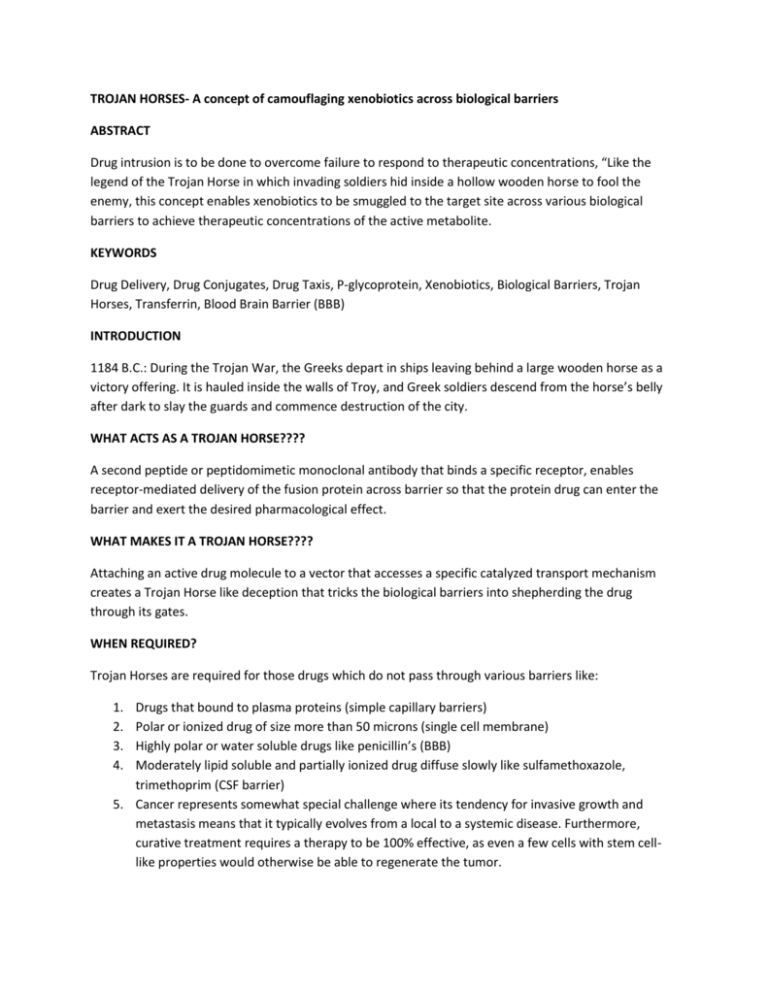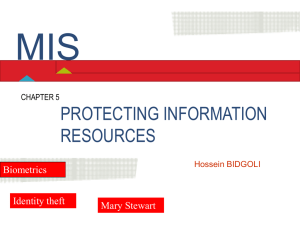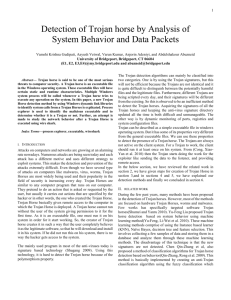TROJAN HORSES- A concept of camouflaging xenobiotics across
advertisement

TROJAN HORSES- A concept of camouflaging xenobiotics across biological barriers ABSTRACT Drug intrusion is to be done to overcome failure to respond to therapeutic concentrations, “Like the legend of the Trojan Horse in which invading soldiers hid inside a hollow wooden horse to fool the enemy, this concept enables xenobiotics to be smuggled to the target site across various biological barriers to achieve therapeutic concentrations of the active metabolite. KEYWORDS Drug Delivery, Drug Conjugates, Drug Taxis, P-glycoprotein, Xenobiotics, Biological Barriers, Trojan Horses, Transferrin, Blood Brain Barrier (BBB) INTRODUCTION 1184 B.C.: During the Trojan War, the Greeks depart in ships leaving behind a large wooden horse as a victory offering. It is hauled inside the walls of Troy, and Greek soldiers descend from the horse’s belly after dark to slay the guards and commence destruction of the city. WHAT ACTS AS A TROJAN HORSE???? A second peptide or peptidomimetic monoclonal antibody that binds a specific receptor, enables receptor-mediated delivery of the fusion protein across barrier so that the protein drug can enter the barrier and exert the desired pharmacological effect. WHAT MAKES IT A TROJAN HORSE???? Attaching an active drug molecule to a vector that accesses a specific catalyzed transport mechanism creates a Trojan Horse like deception that tricks the biological barriers into shepherding the drug through its gates. WHEN REQUIRED? Trojan Horses are required for those drugs which do not pass through various barriers like: 1. 2. 3. 4. Drugs that bound to plasma proteins (simple capillary barriers) Polar or ionized drug of size more than 50 microns (single cell membrane) Highly polar or water soluble drugs like penicillin’s (BBB) Moderately lipid soluble and partially ionized drug diffuse slowly like sulfamethoxazole, trimethoprim (CSF barrier) 5. Cancer represents somewhat special challenge where its tendency for invasive growth and metastasis means that it typically evolves from a local to a systemic disease. Furthermore, curative treatment requires a therapy to be 100% effective, as even a few cells with stem celllike properties would otherwise be able to regenerate the tumor. WHY REQUIRED? To significantly increase the bioavailability of most bioactive molecules. For instance only 20% of the lisinopril, just 40% of furosemide, and less than 1% o calcitonin ever makes it to the patient’s blood stream where it can do some good. “Pharmaceutical firms strive for at least a 60% bioavailability in new drug compounds, but accept 10-20% when there are no alternatives. Trojan Horses offer some new strategies for increasing the bioavailability to at least 60%. EXAMPLES OF TROJAN HORSES AS CARRIERS Trojan Horse drug conjugate, acting as a substrate of a physiological BBB receptor that facilitates transcytosis, significantly improves drug transport into the CNS. Specifically, the low-density lipoprotein receptor-related protein (LRP) is aprotinin-derived peptide, across the BBB. Interestingly, in its conjugated form paclitaxel circumvents the efflux pumps at the BBB but still retains its activity against microtubules. Importantly, the authors were able to demonstrate improved therapeutic efficacy of this approach in models of primary and metastatic cancers. APPLICATIONS: 1. Trojan Horse technique may treat breast cancer proven resistant to chemotherapy. 2. The approach is based on ANG1005, a ‘Trojan Horse’ paclitaxel conjugate posing as substrate of a BBB receptor that facilitates transcytosis, significantly improves survival in orthotopic models of glioma and of brain metastases. ANG1005 is formed by conjugation of paclitaxel to the peptide Anglopep-2. A ligand of the low-density lipoprotein receptor-related protein (LRP). 3. Trojan Horse strategies such as ANG1005 the potential involvement of the respective transporters/receptors in the pathology of various diseases and brain conditions may also need to be considered. For example, LRP has been implicated in Alzheimer’s disease as a factor influencing the metabolism of amyloid- β (Aβ) but also as a receptor for APP, apoE and α2/microtubulin. 4. Trojan Horse therapy blocks buildup of alzheimer’s plaques. A potential new therapeutic approach to Alzheimer’s disease protects brain cells in culture by drastically reducing the neurotoxic amyloid protein aggregates that are critical to the development of the disease. 5. Phthalocyanine-nanoparticle conjugates have been designed and synthesized for the delivery of hydrophobic photo sensitizers for photodynamic therapy (PDT) of cancer. 6. Cancer therapy using a Trojan Horse when the nanoparticle conjugates are incubated with HeLa cells (a cervical cancer cell line), they are taken up thus delivering the phthalocyanine photosensitizer directly into the cell interior. ADVANCES IN TROJAN HORSES Transporters like the insulin receptor transporter protein found on the surface of endothelial cells within the brain acts as a Trojan Horse. A humanized murine antibody has been developed that binds to the human insulin receptor (HIR) and this is suitable for use as a Trojan Horse to deliver pharmaceutical agents to human organs and tissue that express the receptor. Immunoliposome- a one more promising strategy to delivery drugs another targeting approach to delivery drugs across the barriers is by tagging or attaching liposome-containing drugs with an antibody that recognizes receptors along the endothelium. Monoclonal antibodies attached to liposomecontaining drugs can recognize these receptors be recognized as ligands, and be endocytosed thus useful in drug delivery through BBB. Endogenous large-molecule peptides such as transferring, insulin and leptin cross the BBB via attachment to such receptors and cross via receptor-mediated transport. A Step Forward in Virology- Trojan Horse o Viruses Revealed Viruses use various tricks and disguises to invade cells. ETH Zurich researchers have now discovered yet another strategy used by viruses: the vaccinia virus disguises itself as cell waste, triggers the formation of evaginations in cells and is suspected to enter the cell interior before the immune defense even notices. The invasion Strategy The pathogen disguises itself as waste material and tricks cells into digesting it, just as they normally would with the remains of dead cells. As the immune response is simultaneously suppressed, the virus can be ingested as waste without being noticed. Sugar used as ‘Trojan Horse’ to fight cancer While chemotherapy can be administered without difficulty, orally or intravenously, the main drawback is that healthy cells are also affected by the treatment which leads to a number of side effects such as hair loss, nausea and a depressed immune system. However, with the new method, the medicines are encapsulated in microscopic containers with a diameter of just one hundred thousandth of a milli metre that can go through the body unnoticed an finally deliver their load at the point of the illness, which could minimize the side effects and represent major progress in the treatment of cancer. “Each cell would normally resist the entry of the foreign substance, but this is not the case with the nanocapsules because the cells cannot recognize the pharmaceutical load inside them, but think that a tasty little sugar snack is on its way.” A lab-made “chimeric peptide”, for example, is half drug (which does not cross the BBB), and half “molecular Trojan Horse” (which does). Clostridial Spores As “Trojan Horse” Vectors for Cancer Gene therapy virus-based vectors if can’t reach a tumor cell, it can’t act or deliver a therapeutic gene. On the contrary, clostridial spores are able to home in on these niche environments because of their own unique metabolic need, which enable them to utilize the tumor micro milieu and respective tissues for their own proliferation. CONCLUSION The limitations of conventional drug delivery can be directly linked to inefficiency of the drugs to pass through the biological barriers to reach required systemic circulation against physical, metabolic and immunological barriers to achieve effective therapeutic concentrations in organs especially like the brain, CSF and cancer cells. To fully exploit this approach will require more specialized neuroscience reconnaissance missions, particularly of the genomics and proteomics type, in order to unearth the transporter (Trojan Horse) and receptor terrain of the biological barriers, much of which is still a mystery. However, work using the transporting systems that are already well known has demonstrated the strong promise of this method. These biological barriers can be cheated to trespass or shepherd the drugs by the help of Trojan Horses. REFERENCES 1. De Boer AG, Gaillard PJ (2007). Drug targeting to the brain. Annu Rev Pharmacol Toxicol 47: 323355. 2. Deeken JF, Loscher W (2007). The blood-brain barrier and cancer: Transporters, treatment, and Trojan Horses. Clin Cancer Res 13: 1663-1674 3. Demule M. Regina A. Che C, Poirier J. Nguyen T. Gabathuler R et al. (2008). Identification and deisgn of peptides as a newe drug delivery system for the brain. J Pharmacol Exp Ther 324: 1064-1072 4. Fellner S. Bauer B, Miller DS, Schaffrik M, Frankhanel M, Spruss T et al. (2002). Transport of paclitaxel (Taxol) across the BBB in vitro and in vivo. J Clin Invest 110: 1309-1318 5. Herz J (2003). LRP: a bright beacon at the BBB. J Clin Invest 112: 1484-1485










